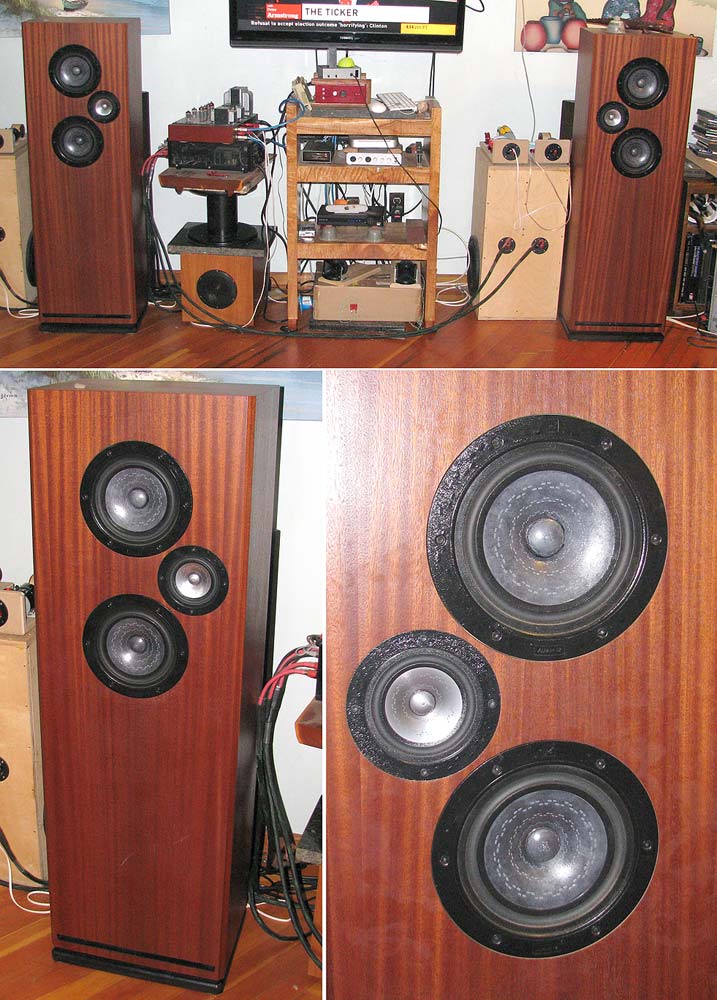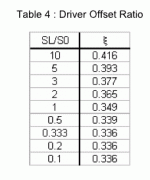Isn't the MTM idea to minimize lobing, especially when using a low cut-off frequency?
More to place the lobing. Once the C-C distance of the 2 midbasses exceeds a forth of the XO wavelength one starts to get lobing which increases as the XO frequency rises.
We did a couple of MTM ML-TLs that keep the driver spacing to less than a quarter wavelength. It works REALLY well. Bass into the mid 20s, really good image/soundstage, more...

dave
Hi Dave,
Wow, you have to go as far as a 1/4 wavelength between the two Ms? One famous local colleague built a few projects with a 1/2 wavelength and his stuff has kick-*** vertical imaging.
Speakers look awesome by the way. I presume you've used a fullrange for the tweeter role?
About the 1/5 wavelength location of the Tweeter, how does it behave from the point of view of cancelling the first unwanted harmonic (third)?
BR,
Alexander
Wow, you have to go as far as a 1/4 wavelength between the two Ms? One famous local colleague built a few projects with a 1/2 wavelength and his stuff has kick-*** vertical imaging.
Speakers look awesome by the way. I presume you've used a fullrange for the tweeter role?
About the 1/5 wavelength location of the Tweeter, how does it behave from the point of view of cancelling the first unwanted harmonic (third)?
BR,
Alexander
Danley clearly showed that quarter wavelength is “magic”. Others have used half or one wavelength because it is near impossible to get the tight spacing with a tweeter.
So the compeomise is a tweeter means giving up the seemless physical distance needed.
It is why we have seen the rise of waveguide loaded tweeters XOed as low as 1kHz, and WAWs where most of the mids and the top are handled by a single driver. It is worth noting that both these give a much more equitable division of labour between 2 drivers. ie about 300 Hz leaves half above & half below.
???
dave
So the compeomise is a tweeter means giving up the seemless physical distance needed.
It is why we have seen the rise of waveguide loaded tweeters XOed as low as 1kHz, and WAWs where most of the mids and the top are handled by a single driver. It is worth noting that both these give a much more equitable division of labour between 2 drivers. ie about 300 Hz leaves half above & half below.
1/5 wavelength location of the Tweeter
???
dave
Alexander,
The 1/5 th wavelength that I have been talking about is in reference to the total length of the transmission line. This length acts to establish the lower bass frequency region performance of the MLTL.
Now the spacing between the mid-bass woofers and the tweeter yields another wavelength (unrelated to the length of the MLTL) which that comes into play in a MTM design. The center-to-center spacing between the mid-bass drivers and the tweeter impacts the performance of the MTM. Most MTMs used in commercial and DIY designers are limited to spacing as high as a wavelength at the crossover frequency because of the physical size of most mid-bass and tweeter drivers. Better performing (more ideal polar patterns) MTMs have spacings of half wavelength or less. Smaller outer diameter tweeters and closer spacing between the drivers improves the theoretical performance of the MTM. Dave has suggested small extended frequency range drivers instead of a conventional tweeter. These permit crossovers at lower frequency points and thus better MTM performance.
Jim
The 1/5 th wavelength that I have been talking about is in reference to the total length of the transmission line. This length acts to establish the lower bass frequency region performance of the MLTL.
Now the spacing between the mid-bass woofers and the tweeter yields another wavelength (unrelated to the length of the MLTL) which that comes into play in a MTM design. The center-to-center spacing between the mid-bass drivers and the tweeter impacts the performance of the MTM. Most MTMs used in commercial and DIY designers are limited to spacing as high as a wavelength at the crossover frequency because of the physical size of most mid-bass and tweeter drivers. Better performing (more ideal polar patterns) MTMs have spacings of half wavelength or less. Smaller outer diameter tweeters and closer spacing between the drivers improves the theoretical performance of the MTM. Dave has suggested small extended frequency range drivers instead of a conventional tweeter. These permit crossovers at lower frequency points and thus better MTM performance.
Jim
Last edited:
Keep in mind that 1/5, 1/4, 1/3 are only estimates. Look to Martin Kings tables for optimum Zd.
dave
dave
Hi guys,
My concern is, why the 1/5 rule doesn't cancel the first parasitic harmonic well on simulation with the Leonard audio software? For some reason, Martin's tables don't match with my current straight enclosure ML-TL simulation. They do only when simulating pure quarter wave resonators without mass loading. Is it because the port adds "artificial length" (lowers resonance)?
My concern is, why the 1/5 rule doesn't cancel the first parasitic harmonic well on simulation with the Leonard audio software? For some reason, Martin's tables don't match with my current straight enclosure ML-TL simulation. They do only when simulating pure quarter wave resonators without mass loading. Is it because the port adds "artificial length" (lowers resonance)?
Attachments
Exactly! Well dave, for a SL/S0 ratio of 1 we can all all see the optimum placement is 0.349 the length. On the simulator, 0.465 seems to be the optimum point. Here are some screenshots:

The driver at 0.465 down the length
 photo upload site
photo upload site
0.349 down the length. Notice the increase of first parasitic harmonic at 150Hz.

The driver at 0.465 down the length
 photo upload site
photo upload site0.349 down the length. Notice the increase of first parasitic harmonic at 150Hz.
There is no proscriptive 'it "should" be xyz' as such.
Well, there is in that until the pipe length is long enough to physically shorten the vent there's no useful 1/4 WL action damping the vent, plus the pipe's CSA impacts proper pipe length, making it an 'xyz' ratio. 😉
Personally like to see a vent pipe reduction back to [near] baffle thickness or better, shift up to a larger vent pipe when practical, like my large Altec cab alignments that in some cases pushes the vent area [Av] to > [Sd], the pioneer's limit for reflex.
Of course you're right about optimal tweeter height, driver, vent points along the pipe, etc.; most of my early tower/column [mostly 'FR' driver] speakers didn't meet the acoustic MLTL 'rules', yet still out performed comparable reflex and smooth enough to snooker some folks to believe I'd figured out some way to get sealed performance with a reflex's ~1/2 octave of extra usable bass performance!
GM
didn't meet the acoustic MLTL 'rules', yet still out performed comparable reflex and smooth enough to snooker some folks to believe I'd figured out some way to get sealed performance with a reflex's ~1/2 octave of extra usable bass performance!
GM
Based on this quote, I will start believing in the accurate performance possibilities of an MLTL design. Thank You!
Thanks! Will re-read it a few times, it's a bit hard for me right now due to Covid19 brain fog, although I'm getting better.
I've been thinking about Dave's idea about using a low- XO fullrange as a tweeter in the MTM.
What do you think of combining Vifa TCF9D with my MG18WK?
Sensitivity is low, but when we put BSC, they should match?
And I'll need a transformer to match the impedance of the TCF9D without loss
Based on this quote, I will start believing in the accurate performance possibilities of an MLTL design. Thank You!
You're welcome!
Give it a try, done right [for the app] it's arguably the best overall vented alignment. After all, Elvis's preferred home/studio speaker was the first MLTL TTBOMK; RCA's Harry Olson's ~1950 prototype developed for a HIFI reference system for the home outlined here: http://ayumi.cava.jp/library/olson.pdf
Singer Elvis Presley in recording studio. News Photo - Getty Images
Can't find the one at home. 🙁
By today's standards, at 38.5" i.d. it would barely qualify, but with such a high effective Fb due to the electronics, setup, it loads too much actually, but is below the recording's signal, so basically an acoustic TT 'rumble' filter.
GM
Good links,thanks! A few days before xmas I typically play a little of Presley's music for the season🙂
Well, have some work to do searching for info on MLTL designs. Accidental MLTL Technique looks like a good starting place since I already use winisd in an obsessive manner!
Well, have some work to do searching for info on MLTL designs. Accidental MLTL Technique looks like a good starting place since I already use winisd in an obsessive manner!
Thanks! Will re-read it a few times, it's a bit hard for me right now due to Covid19 brain fog, although I'm getting better.
I've been thinking about Dave's idea about using a low- XO fullrange as a tweeter in the MTM.
What do you think of combining Vifa TCF9D with my MG18WK?
Sensitivity is low, but when we put BSC, they should match?
And I'll need a transformer to match the impedance of the TCF9D without loss
You're welcome!
On the mend, cool!
I make no attempt to keep up with the plethora of new drivers available these days, so no clue other than some are really popular for one reason or another, but agree that with the advent of really wide range tweeters there's finally a non [large] horn option for MTMs.
Efficiency wise, I'm old school, so always 'shoot' for highest efficiency and shelve as required to yield max practical dynamic headroom [lowest distortion where it counts], so Lpad or old school adjustable pot, though good quality DSP is best overall with modern drivers.
GM
Good links,thanks! .....I already use winisd in an obsessive manner!
You're welcome!
Really need to use Hornresp's Wizards if not planning to learn it in-depth from MJK's docs.
GM
Hi Dave,
As always, great tips. What if I decide to use the fiberglass TG9? It is rated of sensitivity at 87dB at 2.83V. Two Vifas MG18WK will do 90dB/2.83V without BSC. Can I rely on the BSC to make the sensitivity mismatch work?
As always, great tips. What if I decide to use the fiberglass TG9? It is rated of sensitivity at 87dB at 2.83V. Two Vifas MG18WK will do 90dB/2.83V without BSC. Can I rely on the BSC to make the sensitivity mismatch work?
The woofers often need to be 3-6dB more sensitive than the tweeter. Depends on how much BSC you need/want to implement. But the extra gain from the horn often means that one has excess gain at those frequencies so no seperate BSC is needed, sometimes the opposite.
You do not want to pad the woofers.
Going active makes the issue moot (or moves the issue to the gain control on your amps (or in the XO).
dave
You do not want to pad the woofers.
Going active makes the issue moot (or moves the issue to the gain control on your amps (or in the XO).
dave
- Home
- Loudspeakers
- Multi-Way
- MTM in a TQWT type enclosure?
